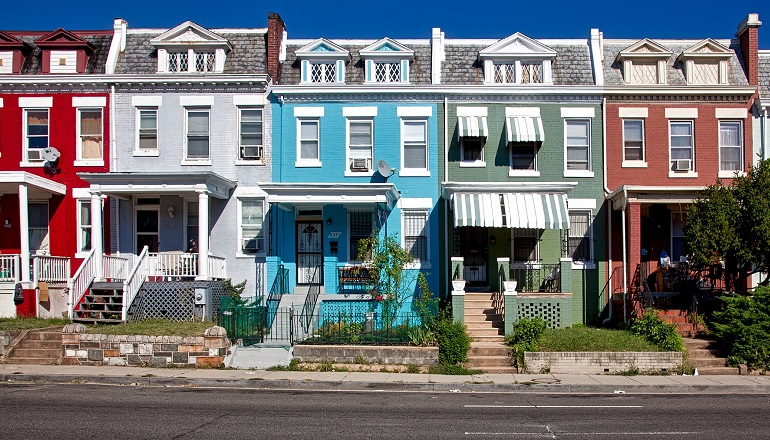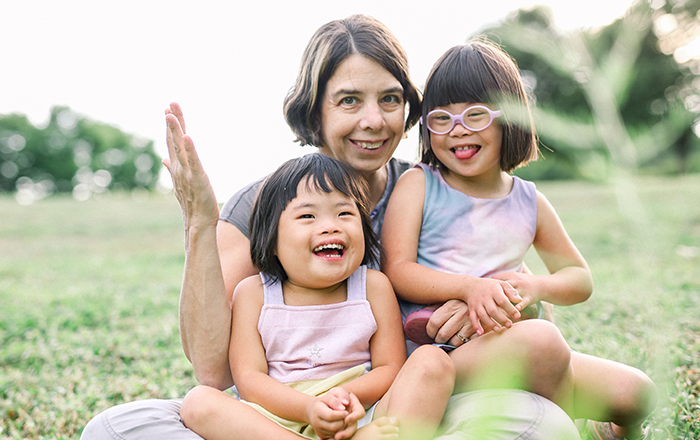Whether it’s piano lessons, green vegetables, or a library card, most parents try to provide for their children all of the ingredients that will ultimately coalesce to create a healthy, secure and independent adult. Adoptive parents have the additional responsibility of helping their children understand their own adoption. For parents of children who have been adopted transracially comes one more responsibility on a plate that may be full, but is not complete, without the commitment to honor and integrate the culture of each family member.
Most parents who adopt a child from another race take their enlarged job descriptions quite seriously. They know that ethnic differences are to be understood and celebrated, not minimized or, worse, dismissed. Translating that knowledge into a daily life that supports the healthy development of transracially adopted children is not easy…especially when the family is not living in a community that reflects its mixed heritage.
Trading Houses
We live in Hawaii; a state known for its ethnic diversity. Our friends are Japanese, Chinese, Hawaiian, Filipino, Korean, and Fijian. While its tempting to let that be “good enough” for our transracial family, the fact is that the largest ethnic groups in our community do not represent our sons African American and Latino heritage.
To compensate, we need to make concerted efforts to connect with members of our child’s cultures; sometimes that means creating opportunities that don’t occur naturally. This summer, we traded houses for two weeks with a family from a multiracial neighborhood in Berkeley, California. They saw the notice we had posted, which started:
“We are Caucasian parents of a seven-year-old African American/Latino son, who want to give our child the opportunity that he, and everyone else, deserves…the chance to see himself reflected in his community and the chance to blend in rather than stick out.”
Most families who can manage to take two weeks of vacation in the summer head to the mountains, to the beach, or to a place like Disneyland—often choosing an experience that is counterpoint to their daily existence. We actually did the same thing, except that we chose to leave our tropical home in Hawaii for an inner city vacation in what some would call the “wrong” neighborhood.
Can We Go Home Now?
After exiting for Berkeley/Oakland from the freeway, we drove through residential streets en route to our temporary home, passing more than a few boarded-up buildings and storefronts as well as three black men sleeping on flattened cardboard boxes in the corner of a city park. I know that most every American city has run-down sections like these; they don’t reflect their larger communities. But here we had traveled 2500 miles in search of positive exposures to people of color, and these were the very first images that greeted us. I learned, within the first hour of our summer experiment, that you can’t orchestrate life to look one way or another.
The house we had traded ours for was, as promised, very convenient to downtown and on a street populated by whites and blacks and families and students. This was closer to what I had in mind. What I didn’t anticipate were the number of mundane setbacks that kept interfering with the multicultural aspirations of our long-anticipated visit.
Even before our bags were unpacked, my son got scratched badly by one of the three cats with whom we were sharing the house, and he started to cry when the TV wouldn’t work. I felt like joining him when I read the note on the dining-room table warning us to “keep the radio on at night and leave a cement block behind the cat door to deter raccoons and burglars.” And, it continued: “Garbage day is Wednesday. Have a great time in our house; we’ll be having a great time in yours.”
Blending Strategies
Our intent was to experience our temporary neighborhood as residents, not as tourists, and we had pre-registered our son for summer day camp at the downtown YMCA. We sent off our little camper that first morning with more than just his lunch box. Our wishes for him included the chance to feel like a full-fledged member of an important group—one that his parents didn’t belong to.
His brown skin assured our son’s anonymity among the 100 or so “Y-Kids.” It didn’t, however, gain him immediate acceptance by his peers. He might have looked like he fit in, but our son was the new kid after all, and that’s as good a reason as any to treat him as “different.” He was different, too, by virtue of having white parents who dropped him off and picked him up. That, he couldn’t change, but in an admirable effort to blend in, our son started speaking a convoluted form of local slang by the third day of camp—and I couldn’t help but respect his adaptability.
When we picked him up in the gym each afternoon at 3:00, my child brought home with him two or three new phrases, acting as if he’d been tossing them around for years. “Mom, I schooled Derrick in soccer,” he told me while I was making dinner. “Oh,” I said innocently, “You taught him some new moves?” “No,” my son snorted, “I whipped his butt big time.” By day four, he had a girlfriend named Kate, two best buddies in his second-grade group called “The Bad Boys,” and a genuine enthusiasm for a camp that “rocked.” He also started shagging his pants because, apparently, the lower your pants could ride, the higher your level of esteem.
The kids at the downtown Berkeley YMCA weren’t all that different from the kids at our local Y, except in small ways…and those small ways can make a big difference to a transracial family like ours. I found my son engrossed in a game of musical chairs when I came to pick him up one afternoon. Instead of running from one chair to another when the music turned on (which is the way I’ve seen it played), these kids were dancing Hip Hop between chairs to the sounds of Snoop Doggy Dogg—and several, like my little guy, would forget to stop when the music did.
We sought other ways to help our child fit in. At a black hair salon in Oakland, I read an old copy of Ebony while we waited for our appointment with Charles. We were unnecessarily prompt and felt somewhat out of place in this all-black salon, but I was also thrilled to be there: with posters of beautiful black women, patrons mouthing the words to songs I’d never heard on the radio, and an opportunity for my son to get the severe buzz cut hed been wanting, complete with a Nike swoosh carved into his little scalp. He winced and smiled. My son loved his hair and walked out of the salon like he had grown a foot.
The Freedom of Fitting In
One of the most delightful feelings for me each afternoon was going to the YMCA to pick up my son and being unable to find him quickly in the moving sea of nimble brown bodies in the gym. This was a new experience for me, and one which I liked a lot. It is usually so easy to pick him out in a crowd among children who don’t look anything like him.
Around Berkeley and Oakland we saw quite a few families that resembled ours. We had the chance to meet many interracial families at a wonderful picnic fortuitously scheduled during our stay in the Bay area by Pact, An Adoption Alliance. It was interesting to see what we must look like to others. I wanted my son to notice, too. In fact, several times during our stay, I wanted to hit him over the head with how many children looked like him and how many families looked like ours. But I didn’t want to make too big a deal about how different it was to be the same as others. My son, I realized, needs to get it at his own pace in his own way.
While my child never said a word about the ethnicity of his new African American and Latino friends, counselors, and neighbors, I felt a weight lifting from my shoulders that I usually carry around at home, where I have to work a lot harder to sustain the cultural connections weve built. This was turning out to be a vacation, after all.
I would be kidding myself to think that two weeks in this environment fulfills my responsibility to my son or satisfies his birthright to be connected to his culture. I know that it’s a daily commitment wherever we are to populate our life with people and thoughts that strengthen identity. But it sure was nice to live in a place where access to people of your child’s birth heritage is not forced.
Unexpected Lessons
Our decision to send our son to day camp at the YMCA, instead of to a program five minutes away at the Lawrence Hall of Science on the UC Berkeley campus, was based on learning that he would find a greater percentage of people of color—both campers and counselors—at the Y. It is also there, we were aware, that he would encounter children from a lower socio-economic group than his own, which was fine, as long as he didn’t get a skewed view of what it means to be African American or Latino.
Like many of the issues good parents worry about, this wasn’t much of an issue to my child. I began thinking about class differences the day my son’s tokens were stolen by another child at the video arcade. Mind you, he had left them in a pile on top of the video game he was playing. I realized then that our child’s nonchalance about protecting his stuff is based on his attitude of abundancea navet, really—that comes from his upbringing in a family where there is always enough and there will always be more: whether it is food, clothing, medical attention, or tokens.
I’m afraid that my husband and I, in looking for a house trade this past summer, were myopically focused on race-matching. We accepted to trade for a house and a neighborhood that were not as nice as ours, but we neglected to think about the benefits of trying to match socio-economic levels, as well. Had we traded for a racially diverse neighborhood in a middle-class community like the one we left, racial differences would not be compounded by disparities in economic levels. Chances are, there would be more common ground between us and our neighbors in terms of shared interests and hopes for our children.
Did It Work?
It is hard to measure the long-term impact of our short-term multi-cultural experience. The souvenirs my son brought back home with him include memories of great times with new friends, as well as a new pen pal, a new haircut, a clear preference for rap music, and an understanding that there are places in this country and in this world where people of color are in the majority. The changes I’ve seen are small, but not too small to celebrate: such as using pomade in his hair each —”like a lot of the boys in Berkeley do,” or choosing the brown crayon to color all of the faces on a child’s menu at a restaurant.
The temporary environment we created this summer by trading neighborhoods is somewhat artificial. Yet, we believe that each experience makes a small deposit in the formation of our sons positive identity as a person of color and in our family’s positive identity as a mixed unit.
Truth is, there is no recipe for how to become a healthy, mixed-race family. We take the information we have—about the value of role models, birth families, support groups, and continuous learning—and make these the ingredients for growing up whole.



